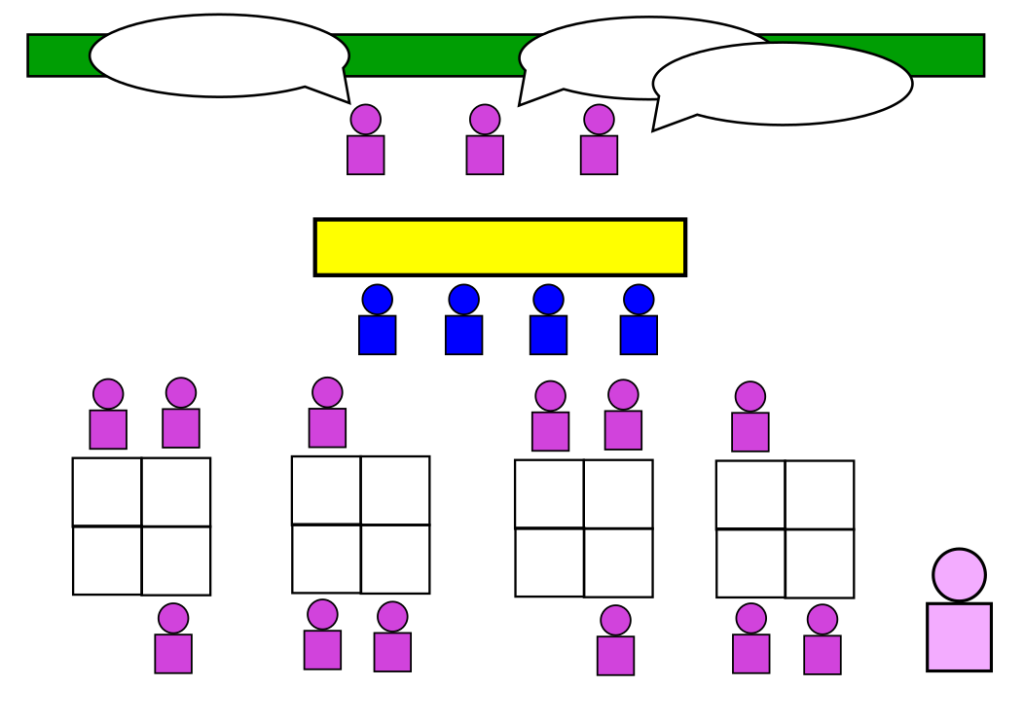(Editor’s note: this post is part of my not-necessarily math related posts. I spend a good portion of time in non-math classes these days. And thank goodness, because it exposes me to practices that I wouldn’t otherwise have experienced.)
I had the pleasure of sitting in on some student presentations on a recent site visit to a school. The presentations were for a English-Social Studies project in which students were giving a “Shark Tank” style pitch for a particular social issue. The format of the presentation was fantastic.
Before I describe the presentation format in question, let me describe how my (read: bad) presentation formats went.
- Students present solutions
- I ask, “Any questions from the audience?”
- *crickets chirping*
- I say, “So uhh… how did you convert miles per hour into kilometers per minute?” Presenters respond.
- *every student except the three or four students presenting are staring at the clock and not paying attention in any way whatsoever*
- I say, “Any other questions?”
- *crickets have stopped chirping and have now also fallen asleep*
- I say, “Thanks gang! Who’s next?”
- Repeat with the next group
By about the third set of student presentations I was barely paying attention. Part of that was probably the oft-poor design of the problem or project at hand – it is said when multiple groups are presenting the same solution, they didn’t solve a problem, they followed a recipe – but it was also due to the nature of the presentation format. Even when solutions were different, or solution paths varied, I had the same problem of “any questions?” followed by silence.
Scripted initial questions, student panels, reconvening with deeper questions
The following presentation format was the brainchild of Kay and Chizzie. And it resulted in a level of student-to-student discourse more authentically than I ever achieved.
Here’s how the presentation format went according to this “Shark Tank” project.
- Students presented their work. They had about 30 seconds.

- A few students served as a panel (if we’re sticking with “Shark Tank”, these are your Mark Cubans, your Mr. Wonderfuls, etc.). The teacher had prepared a few scripted questions, which the panel asked psuedo-randomly. The presenters knew these questions ahead of time and had to be prepared to answer them.

- Students responded to the questions that were selected.

- The panelists convened with their groupmates to discuss the presenters’ responses and to develop deeper, more probing questions. The presenters also had a couple minutes to regroup and confer.

- After convening, the panelists return to their station and ask the questions that they and their group came up with. The presenters respond. From this point, it becomes semi-conversational as all the panelists are interested in getting their question answered.he presenters then answered those questions, which were generally more specific in nature and based on the initial responses of the presenters.

The two design features that separates this presentation format from my terribly ones are the following:
Design feature 1) Having a few “starter” questions that the students were aware of ahead of time, if only to get the conversation started.
Design feature 2) Letting the panelists confer about what they just heard with their group before proceeding to ask further questions.
There are so many things I like about this format over my non-format. Let me break down all the ways in which I like it:
- Having a set of pre-written questions (designed by the teacher, presumably, but asked by the students). This got the conversation going. It normed the students into question-asking mode. Even though the questions were scripted, it was coming from the panelists and the presenters were speaking to the panelists. It became a conversation which allowed for more, in-depth explanation and gave the class more info to go on when designing their deeper, more specific questions.
- The format involves the entire class during presentations. Even students who aren’t part of the panel or the presentation need to pay attention in order to design deeper questions upon convening.
- Students have an opportunity to brainstorm and develop questions at a not-immediate pace, rather than coming up with questions on the spot. It’s hard enough for you and I as teachers to ask immediate off-the-cuff questions, in retrospect it was probably foolish of me to expect that of students in a consistent manner.
- Conversations during the convening pretty much necessitated that kids pay attention to the content presented by the other groups.
Despite it being toward the end of the class period and several presentations already having been given, students were still engaged in the questioning process. And of the presentations I saw, student panelists asked excellent, varied questions after convening with their group mates. The group conversations during the convening were meaningful and related to the content presented. Everything I’d hope for in a formal presentation of learning to peers.
I’m sure there are also some meta-lessons to learn: giving students time and space to develop their questions, scaffolding the design of questions via some scripted prompts, and the like. While the premise of the project at hand was tied to the “Shark Tank” format, I see no reason why this or something like it couldn’t be a ubiquitous presentation format for a class throughout the entire year, or, better yet, an entire school.